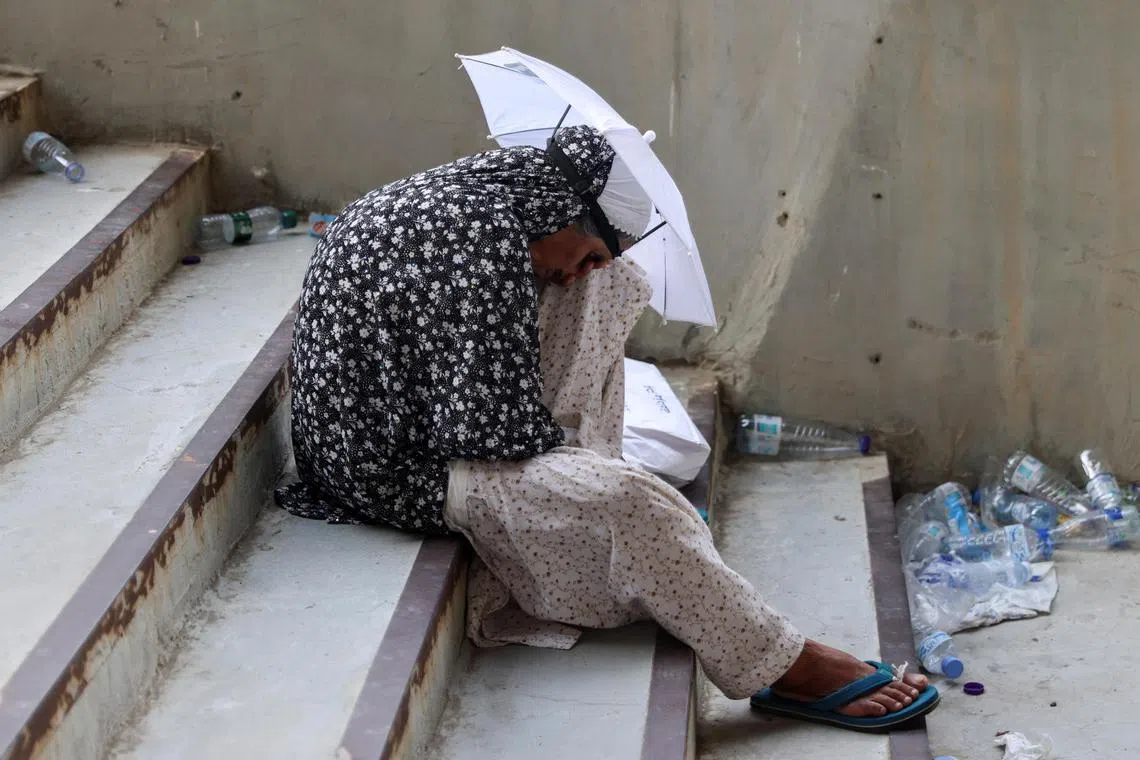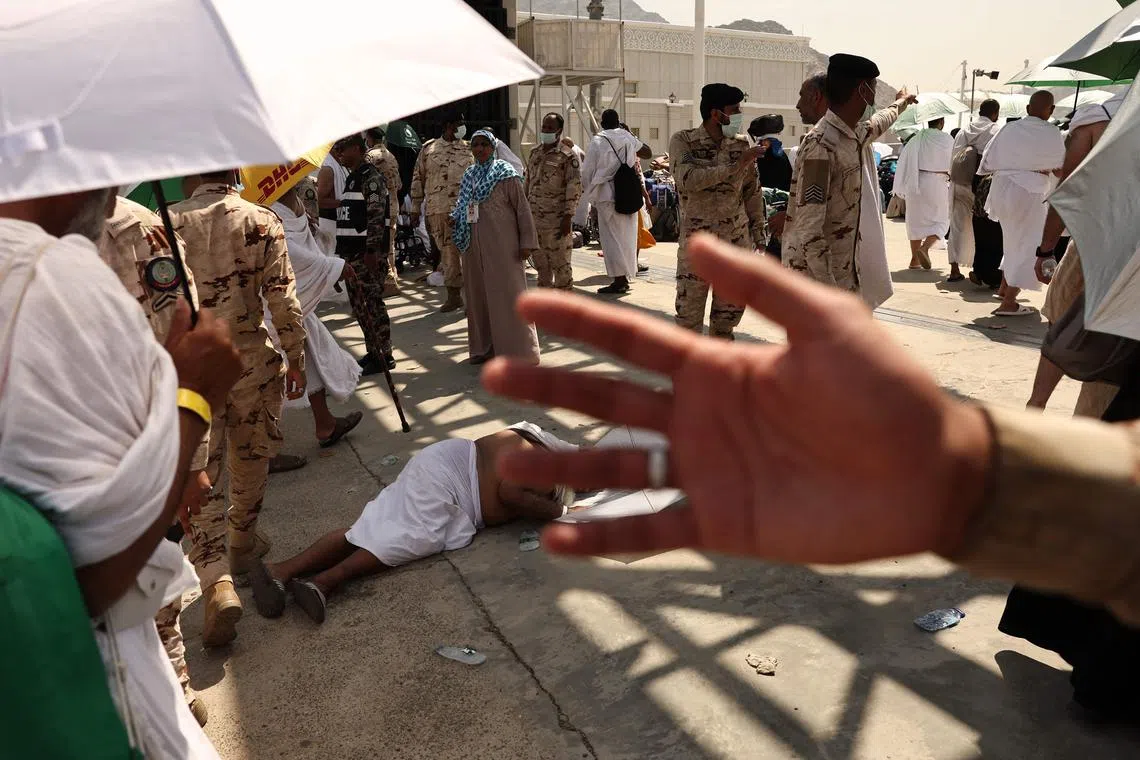More than 1,000 haj pilgrims die in Mecca as mercury hits 51.8 deg C
Sign up now: Get ST's newsletters delivered to your inbox

A pilgrim using an umbrella as a shield from the sun during the haj pilgrimage, in Mina, Saudi Arabia, on June 16.
PHOTO: REUTERS
Follow topic:
RIYADH – The death toll from the 2024 haj exceeds 1,000, an AFP tally said on June 20, with unregistered pilgrims making up more than half of those who perished amid intense heat.
The new deaths reported included 58 from Egypt, according to an Arab diplomat who provided a breakdown showing that of a total of 658 dead from that country, 630 were unregistered.
Friends and relatives have been searching for missing haj pilgrims as the death toll rises at the annual rituals, which were carried out in scorching heat. People scoured hospitals and pleaded online for news, fearing the worst after temperatures hit 51.8 deg C in Mecca, Islam’s holiest city, on June 17.
About 1.8 million people from all over the world, many old and infirm, took part in the days-long, mostly outdoor pilgrimage, held during the oven-like 2024 Saudi summer. Around 10 countries have reported 1,081 deaths during the haj, with the figures coming from official statements or from diplomats working on their countries’ responses.
An Arab diplomat told AFP that deaths among Egyptians alone had jumped to more than 600 from over 300 a day earlier, mostly from the unforgiving heat.
Mrs Mabrouka Salem Shushana of Tunisia, in her early 70s, has been missing since the climax of the pilgrimage on June 15 at Mount Arafat, her husband Mohammed told AFP on June 19.
Because she was unregistered and did not have an official haj permit, she was unable to access air-conditioned facilities that allow pilgrims to cool down, he said.
“She’s an old lady. She was tired. She was feeling so hot, and she had no place to sleep,” he said. “I looked for her in all the hospitals. Until now, I don’t have a clue.”
Facebook and other social media networks have been flooded with pictures of the missing and requests for information. Those searching for news include family and friends of Egyptian pilgrim Ghada Mahmoud Ahmed Dawood, unaccounted for since June 15.
“I received a call from her daughter in Egypt begging me to put any post on Facebook that can help track her or find her,” said one family friend based in Saudi Arabia, who spoke on condition of anonymity because he did not want to anger the Saudi authorities. “The good news is that... we did not find her on the list of the dead people, which gives us hope she is still alive.”

A member of the Saudi security forces preventing people from approaching a man affected by the scorching heat lying on the ground in Mina, near Saudi Arabia’s holy city of Mecca, on June 16.
PHOTO: AFP
Searing heat
The haj is one of the five pillars of Islam, and all Muslims with the means must complete it at least once. Its timing is determined by the Islamic lunar calendar, shifting forward each year in the Gregorian calendar.
For the past several years, the mainly outdoor rituals have fallen during the sweltering Saudi summer. According to a Saudi study published in May, temperatures in the area are rising 0.4 deg C each decade.
The timing of the haj moves back about 11 days each year in the Gregorian calendar, meaning that in 2025, it will take place earlier in June, potentially in cooler conditions.
A 2019 study by the journal Geophysical Research Letters said because of climate change, heat stress for haj pilgrims will exceed the “extreme danger threshold” from 2047 to 2052, and 2079 to 2086, “with increasing frequency and intensity as the century progresses”.
Hosting the haj is a source of prestige for the Saudi royal family, and King Salman’s official title includes the words “Custodian of the Two Holy Mosques”, in Mecca and Medina.
The haj has been the scene of a number of stampedes and fires over the years, most recently in 2015, when a stampede during the “stoning the devil” ritual in Mina, near Mecca, killed up to 2,300 people in the event’s mostly deadly disaster.
Fatalities have also been confirmed by Jordan, Indonesia, Iran, Senegal, Tunisia and Iraq’s autonomous Kurdistan region, though in many cases, the authorities have not specified the cause.

A woman affected by heat resting under an umbrella as pilgrims arrive to perform the symbolic “stoning of the devil” ritual, in Mina, near Mecca.
PHOTO: AFP
New fatalities were confirmed on June 20 by Pakistan and Indonesia. Out of around 150,000 pilgrims, Pakistan has so far recorded 58 deaths, a diplomat briefed on the tally told AFP.
“I think given the number of people, given the weather, this is just natural,” the diplomat said.
Indonesia, which had around 240,000 pilgrims, raised its death toll to 183, according to its Ministry of Religious Affairs, compared with 313 deaths recorded in 2023.
A second Arab diplomat on June 19 said Jordanian officials were looking for 20 missing pilgrims, though 80 others who were reported missing were found in hospitals.
An Asian diplomat told AFP there were “around 68 dead” from India and that others were missing.
“Some (died) because of natural causes and we had many old-age pilgrims. And some (deaths) are due to the weather conditions, that’s what we assume,” he said.
Two diplomats said on June 20 that the Saudi authorities had begun the burial process for dead pilgrims, which involves cleaning up the bodies, putting them in white burial cloth and taking them to be interred in individual graves.
“The burial is done by the Saudi authorities. They have their own system, so we just follow that,” said one diplomat, adding that his country was working to notify loved ones of the dead as best it could.
The other diplomat said that given the number of fatalities, it would be impossible to notify many families ahead of time, especially in Egypt, which accounts for so many of the dead.
Saudi Arabia has not provided information on fatalities, though it reported more than 2,700 cases of “heat exhaustion” on June 16 alone.
‘No news’
Each year, tens of thousands of pilgrims attempt to perform the haj through irregular channels as they cannot afford the often costly official permits.
This has become easier since 2019, when Saudi Arabia introduced a general tourism visa, said Mr Umer Karim, an expert on Saudi politics at the University of Birmingham.
“Before, the only people who could have done that were residents of the kingdom, and they know the situation,” he said. “For these tourist visa guys, it’s like being on the migrant route without any idea of what to expect.”

Medics tending to a man as pilgrims make their way towards Saudi Arabia’s Mount Arafat, on June 15.
PHOTO: AFP
Even pilgrims who have official permits can be vulnerable, including Egyptian pilgrim Houria Ahmad Abdallah Sharif, 70, who has been missing since June 15.
After praying on Mount Arafat, she told a friend she wanted to go to a public bathroom to clean her abaya, but she never came back.
“We’ve searched for her from door to door and we have not found her,” said the friend, who also spoke on condition of anonymity.
“We know many who are still searching for their family members and relatives and they are not finding them, or if they are finding them they are finding them dead,” the friend added. AFP

